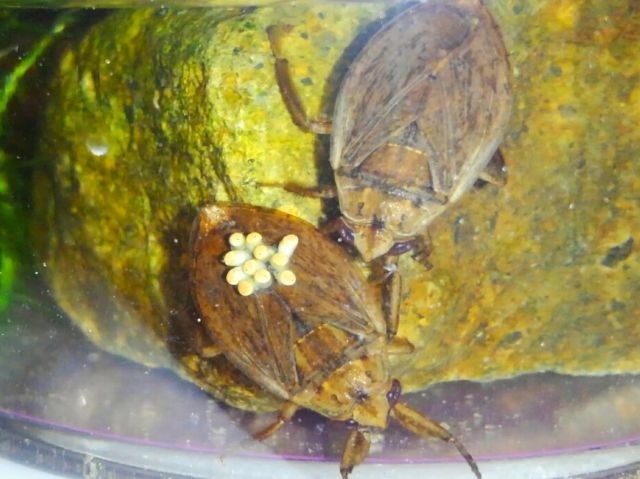Caring fathers aplenty in Japanese giant water bug
Males of the Japanese giant water bug take care of eggs – even of eggs that have been fertilized by other males. Publications by Shin-ya Ohba and Tomoya Suzuki describe this exceptional paternal care.
In the Japanese giant water bug, males care for eggs until they hatch, and they meet the need for care adequately, Shin-ya Ohba and colleagues write. This is remarkable, because care for offspring is rare among insects, and care provided exclusively by the father is even more so.
More peculiar, a third of the eggs a male cares for was fertilized not by himself, but by other males, as Tomoya Suzuki and colleagues were surprised to find.
The Japanese giant water bug, Appasus japonicus, lives in freshwater bodies in Japan and Korea. Within the family of giant water bugs (the Belostomatidae) it is only a small one. It grows to a maximum length of 2 centimeters, while there are also species that measure up to 12 centimeters. Paternal care occurs in many species in this family.
Investment
A male Japanese giant water bug begins his caregiving task by inviting a female to mate with him. He advertises himself with an up-and-down movement. After mating, she sticks fertilized eggs on his back, starting in the middle. When she is finished, he looks for another female to mate with. She adds her eggs. After an average of four matings, his back is fully occupied. A male can carry 100 to 150 eggs, a female lays a few dozen at most.
The eggs require careful treatment: on the one hand, the male must keep them wet and on the other hand, expose them to the air to provide them with sufficient oxygen. He gets this done by staying at the water surface and, with a slow pumping motion, holding the eggs now just above water level and then just below water level. It takes a week to a month for them to hatch, depending on the temperature. During this period, the father can hardly swim and forage because of his burden. He also runs a greater risk of falling victim to a predator. The care therefore requires considerable investment.
Because a male is busy with the eggs for weeks, you would expect that the number of available males is limited, and females must fight for a back where they can lay eggs on. But that turns out not to be the case: males keep up well with females’ egg production and there are enough unoccupied places.
Sperm storage
A male allows a female to lay eggs only if he has mated with her, so that he can be the father of the offspring. Still, on average one in three eggs is ‘foreign’: fertilized by another male. This is not what the researchers had expected when they allowed forty animals – twenty males and twenty females – to mate freely in a tank and determined the relationships between hatched young and adult animals using DNA analyses.
The explanation is that females store sperm and can use sperm from a previous partner instead of the male on which she is currently laying her eggs. And so virtually every male cares for young that are not all his own.
But would not only behavior continue to exist that results in a large number of own offspring? Does paternal care for young make evolutionary sense if paternity is so uncertain?
Yes: in the case of the Japanese giant water bug, it is understandable that a male takes care of other males’ offspring. First, most of the eggs he carries will be fertilized by himself. If he does not take care of them, they are lost. Foreign eggs automatically benefit, but that is just the way it is.
Egg carrier is attractive
In addition, females prefer a male that is carrying eggs over a male with an empty back, previous research has shown. So, eggs on his back – whether fertilized by himself or by another male – increase his chances. And perhaps a female that mates with him will later fertilize eggs with his sperm too and stick them on another male. He may carry some eggs of another father, but another male may take care of his offspring.
The preference of females for males that are already carrying eggs is understandable. A male aims to fill his back within a single day, so that all eggs are the same age and will hatch at the same time. If he collects only a few eggs on a certain day, it is not worth the effort to care for them. He removes them, and they die. By choosing a male that is already carrying eggs, a female reduces that risk for her eggs.
Because foreign eggs are hardly an extra burden and increase a male’s attractiveness, the care for other bugs’ young persists. Ultimately, it benefits a male.
Willy van Strien
Photo: Appasus japonicus, male carrying some eggs and female. © Shin-ya Ohba
Sources:
Ohba, S., R. Hayashida & T. Suzuki, 2025. Female-female competition in two giant water bug species. Ecological Entomology, online 19 May. Doi: 10.1111/een.13454
Suzuki, T., S. Ohba & K. Tojo, 2025. Reproductive strategies in paternal care and remarkably low paternity level in a giant water bug. Ecology and Evolution 15: e71316. Doi: 10.1002/ece3.71316
Ohba, S., N. Okuda & S. Kudo, 2016. Sexual selection of male parental care in giant water bugs. Royal Society Open Science 3: 150720. Doi: 10.1098/rsos.150720
